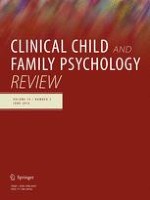07-03-2016
Dyadic Affective Flexibility and Emotional Inertia in Relation to Youth Psychopathology: An Integrated Model at Two Timescales
Gepubliceerd in: Clinical Child and Family Psychology Review | Uitgave 2/2016
Log in om toegang te krijgenAbstract
The current review examines characteristics of temporal affective functioning at both the individual and dyadic level. Specifically, the review examines the following three research questions: (1) How are dyadic affective flexibility and emotional inertia operationalized, and are they related to youth psychopathology? (2) How are dyadic affective flexibility and emotional inertia related, and does this relation occur at micro- and meso-timescales? and (3) How do these constructs combine to predict clinical outcomes? Using the Flex3 model of socioemotional flexibility as a frame, the current study proposes that dyadic affective flexibility and emotional inertia are bidirectionally related at micro- and meso-timescales, which yields psychopathological symptoms for youth. Specific future directions for examining individual, dyadic, and cultural characteristics that may influence relations between these constructs and psychopathology are also discussed.
